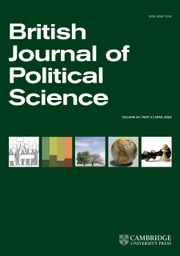Article contents
‘Divisive’ Primaries: The Important Questions
Published online by Cambridge University Press: 27 January 2009
Extract
A small, but apparently expanding, area of research in the United States has developed around the issue of whether divisive primary elections harm the general election prospects of the winners of such primaries. The subject matter is important, being of interest to students of intra-party democracy, party organization and voting behaviour. Unfortunately the research reported in major American political science journals has been directed, with one exception, towards a trivial question, at the expense of the more complex and interesting ones. The purpose of this Note is to explain why this question is not even a poor substitute for them, and to suggest the problems towards which research in this area should be directed.
Information
- Type
- Notes and Comments
- Information
- Copyright
- Copyright © Cambridge University Press 1979
References
1 Hacker, Andrew, ‘Does a “Divisive” Primary Harm a Candidate's Election Chances?’, American Political Science Review, LIX (1965), 105–10CrossRefGoogle Scholar; Johnson, Donald and Gibson, J., ‘The Divisive Primary Revisited’, American Political Science Review, LXVIII (1974), 67–77CrossRefGoogle Scholar; Piereson, James E. and Smith, T. B., ‘Primary Divisiveness and General Election Success: A Reexamination’, Journal of Politics, XXXVII (1975), 555–62CrossRefGoogle Scholar; Bernstein, Robert A., ‘Divisive Primaries do Hurt: U.S. Senate Races 1956–72’, American Political Science Review, LXXI (1977), 540–5.Google Scholar
2 The exception is the article by Johnson and Gibson which examined defection rates amongst party workers in a congressional district in Iowa where there were primaries in both parties. A sceptical statement of the value of aggregate election statistical research in this subject area is contained in Jewell, Malcolm E. and Olson, D. M., American State Political Parties and Elections (Homewood, Ill.: Dorsey Press, 1978), p. 174.Google Scholar
3 Hacker and Piereson and Smith find that ‘divisive’ primaries are not harmful; Bernstein reaches the opposite conclusion.
- 28
- Cited by

